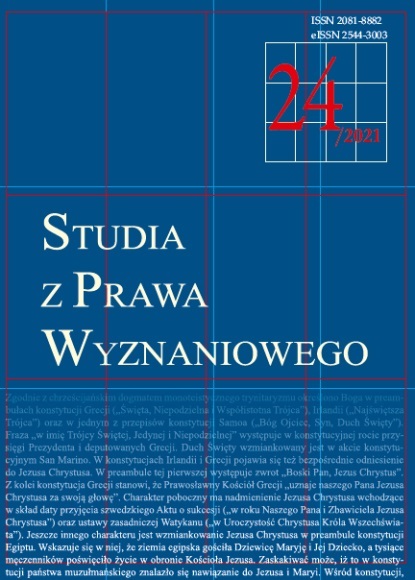Mechanizm limitacji prawa do wolności uzewnętrzniania przekonań religijnych w międzynarodowym systemie ochrony praw człowieka ze szczególnym uwzględnieniem kontekstu europejskiego
The mechanism of limiting the right to the freedom to manifest religious beliefs in the international system of human rights with a particular emphasis on the European context
Author(s): Maciej KubalaSubject(s): Law, Constitution, Jurisprudence, Constitutional Law, International Law, Human Rights and Humanitarian Law, EU-Legislation
Published by: Katolicki Uniwersytet Lubelski Jana Pawła II - Wydział Prawa, Prawa Kanonicznego i Administracji
Keywords: system ochrony praw człowieka; wolność sumienia i religii; przekonania religijne; Karta Praw Podstawowych UE;system of human rights protection; freedom of conscience and religion; religious beliefs
Summary/Abstract: Article 18 of the Universal Declaration of Human Rights provides that the right to the freedom of thought, conscience and religion (along with the freedom to change one’s religion or belief) includes the right to manifest religious beliefs. In the international system of human rights protection built after the Second World War, the aim of the Declaration was to proclaim human rights as an international standard and consequently, to define the notion of human rights as used in the United Nations Charter. In parallel to Article 18 of the Declaration, the right to the freedom to manifest religious beliefs is recognized by Article 9 of the Convention for the Protection of Human Rights and Fundamental Freedoms, Article 18 of the International Covenant on Civil and Political Rights and Article 10 of the Charter of Fundamental Rights of the European Union – treaties concerning human rights, important for the European understanding of the standard of protection of the right to manifest religion or beliefs on the transnational and regional level. The second paragraphs of the Convention and the Covenant contain limitation clauses that permit the limitation of the freedom to manifest religious beliefs. The Charter draws – though not without reservations – from the Convention’s protected rights, including limitation mechanisms. The analysis presented in this paper is conducted using the legal dogmatic method. In order to contribute to a better understanding of the practical and legal consequences of the implementation of the theoretical assumptions of the limitation clauses in the treaty provisions protecting the freedom to manifest religious beliefs, which are important from the European perspective, the author discusses the relevant provisions of the Convention, the Covenant and the Charter and analyzes the conditions of legal admissibility of limiting the right to manifest religious beliefs under the international instruments under discussion.
Journal: Studia z Prawa Wyznaniowego
- Issue Year: 2021
- Issue No: 24
- Page Range: 301-325
- Page Count: 25
- Language: Polish

